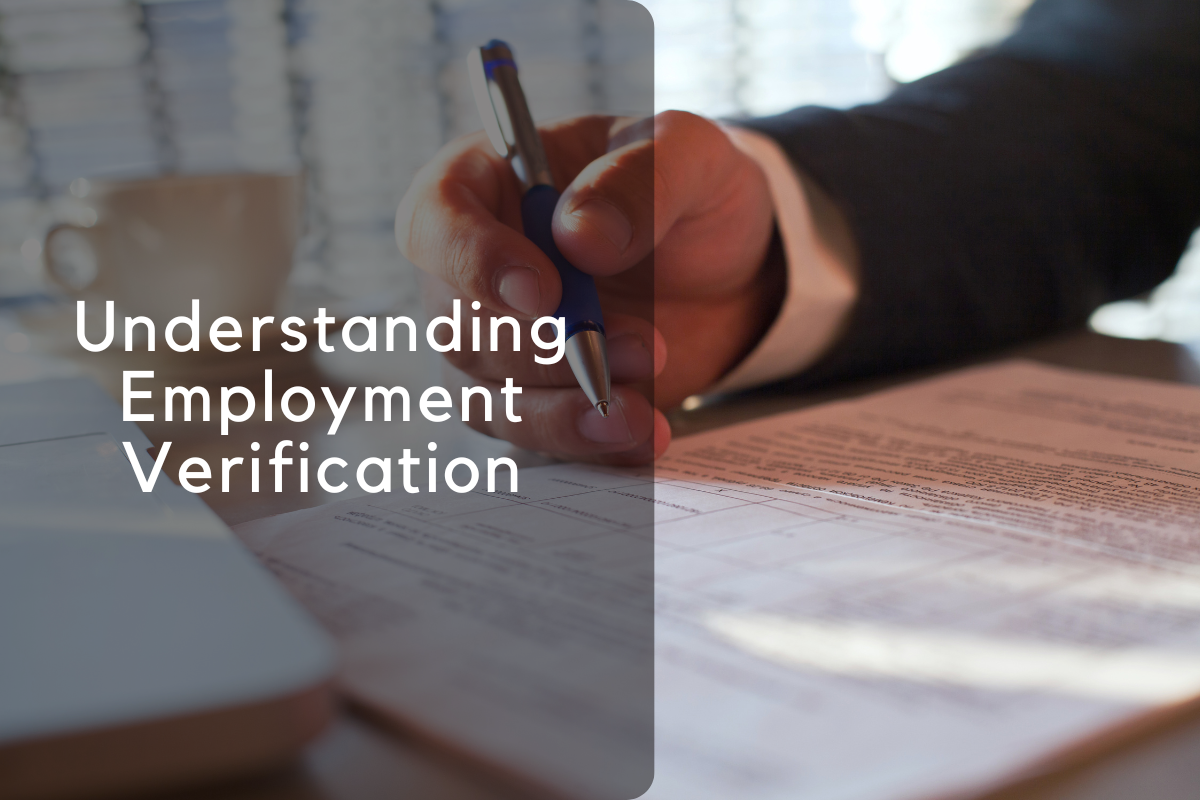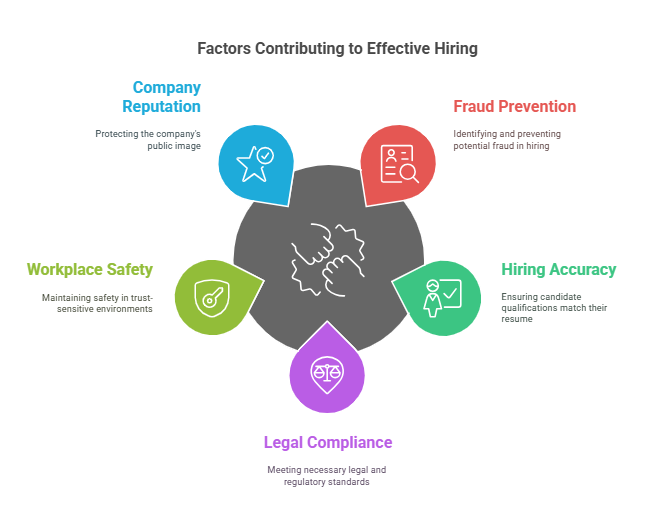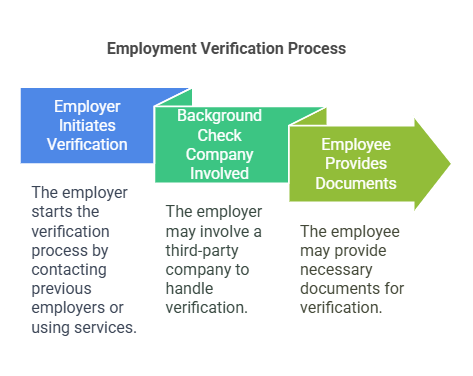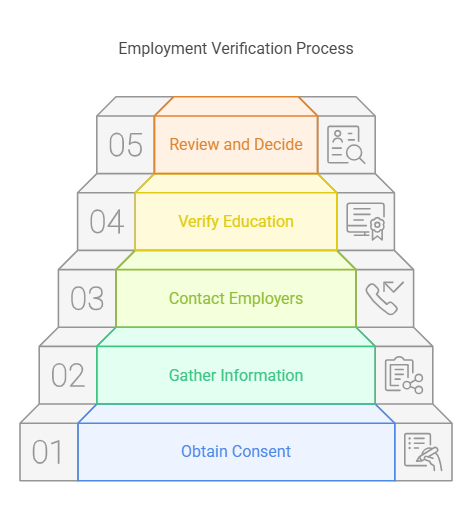Table of Contents
ToggleWhat is Employment Verification?

Employment verification is a critical process that employers use to confirm the accuracy of a job applicant’s employment history and background. It involves confirming key details, such as previous employers, job titles, dates of employment, and sometimes reasons for leaving. This step is vital for employers to ensure that the candidate’s qualifications match what is stated on their resume or job application. Employment verification helps employers make informed decisions when hiring new staff and ensures the integrity of their workforce.
Why is Employment Verification Important?

Employment verification plays a significant role in many hiring processes for several reasons:
- Fraud Prevention: By verifying the details of a candidate’s employment history, employers can identify and prevent potential fraud. This is especially important in cases where applicants exaggerate or falsify their experience or qualifications to increase their chances of securing the job.
- Hiring Accuracy: Employment verification ensures that the candidate’s previous work history matches their resume, providing a more accurate picture of their qualifications. This helps employers make better hiring decisions based on proven experience and skillset.
- Legal Compliance: Many industries require certain qualifications or work history to comply with government regulations. Employment verification ensures that candidates meet the necessary legal and regulatory standards for specific roles.
- Workplace Safety and Trust: Verifying a candidate’s employment history can help prevent any safety concerns in workplaces that require high levels of trust, like healthcare, education, and security services.
- Protecting Company Reputation: Employers want to ensure they are hiring trustworthy employees who can maintain a positive reputation for the company. Employment verification helps screen out candidates who might misrepresent themselves.
What Information is Included in an Employment Verification?
During the employment verification process, several key pieces of information are typically confirmed:
- Dates of Employment: Confirming the start and end dates of a candidate’s previous employment helps ensure the accuracy of the candidate’s employment timeline.
- Job Titles and Roles: Employers confirm that the job titles and responsibilities listed by the candidate match those from their previous employer, ensuring they meet the job requirements.
- Reason for Leaving: Employers may inquire about the reason for leaving a previous job to understand if there were any issues related to performance or behavior.
- Eligibility to Work: Some employers may verify whether a candidate was legally employed during their time at a previous job, ensuring they have the legal right to work in the country.
- Salary Information (in some cases): Some employers may ask about the salary or hourly wages of a candidate’s previous position to understand their pay expectations.
Who Performs Employment Verification?

Employment verification can be performed by a few different parties, depending on the situation:
- Employers: In the majority of cases, the current or prospective employer conducts employment verification. This may involve directly contacting the candidate’s previous employers, using third-party background screening services, or utilizing online verification systems.
- Background Check Companies: Many companies, especially large organizations, outsource employment verification to third-party background check providers. These providers have systems in place to quickly verify the employment history of candidates by reaching out to previous employers and gathering the necessary documentation.
- Employee or Candidate: In some instances, the employee or job applicant may be responsible for providing their employment verification documents, such as pay stubs, W-2 forms, or other documentation that confirms their employment.
Types of Employment Verification Checks
Various types of employment verification checks can be conducted to ensure the accuracy of a candidate’s employment history. The most common checks include:
- Basic Employment Verification: This is the most common type of check, which verifies the applicant’s past employers, job titles, and dates of employment.
- Criminal Background Check: This type of check is often done in addition to employment verification to ensure a candidate does not have a criminal history that might affect their suitability for the job.
- Education Verification: Some employers also verify the educational qualifications of candidates, such as degrees and diplomas earned, to ensure that they meet the requirements for the job.
- Reference Checks: Employers may contact professional references provided by the candidate to learn more about their work performance, character, and qualifications.
- Drug Screening: For certain positions, especially those in transportation, healthcare, and safety-sensitive roles, employers may conduct drug screenings as part of the hiring process.
The Process of Employment Verification A Step-by-Step Guide

Employment verification is a thorough process that can be completed either by the employer or through third-party service providers. The verification process is essential to ensure the accuracy of the candidate’s employment history and other related information. It helps prevent fraud and ensures that the candidate is qualified for the position they are applying for. Below is a detailed, step-by-step guide to understanding how the employment verification process works.
Step 1: Obtaining Consent from the Candidate
Before an employer or background check company can begin the verification process, the candidate must provide consent. This consent is usually granted by the candidate signing a release form, which allows the employer or the background screening company to contact previous employers and other relevant entities for verification purposes.
- Why is this step necessary?
- Legal compliance: Employers are required to obtain written consent from the candidate before conducting background checks or employment verifications due to privacy laws and regulations such as the Fair Credit Reporting Act (FCRA).
- Transparency: This process ensures that the candidate is aware of the background checks and the information that will be disclosed during verification.
Step 2: Gathering Relevant Information
Once the candidate has consented, the next step involves gathering all the necessary details required to verify the employment history. This includes information such as:
- Company names and contact details: The candidate’s previous employers and their respective contact information.
- Job titles and positions held: This includes the specific roles held by the candidate in their previous employment.
- Employment dates: These are the start and end dates of the candidate’s previous employment.
- Reason for leaving (if applicable): Employers may request the reason why the candidate left their previous positions.
Step 3: Contacting Previous Employers or Third-Party Verification Services
Once the required information is gathered, the next step is to reach out to previous employers to confirm the details provided by the candidate. Employers can do this by:
- Direct contact with previous employers: This is the most traditional method of employment verification, where the current employer or a third-party background check company directly calls or emails the previous employer to confirm the details.
- Using employment verification services: Many employers choose to use third-party verification services, such as those offered by www.rapidhiresolutions.com, which streamline the verification process. These services provide a more efficient way of confirming employment history, often using automated systems that quickly access and verify employment records from previous employers.
Step 4: Verifying Education and Additional Information (if applicable)
In addition to verifying employment history, employers may also verify the candidate’s educational background and other qualifications. This step may involve confirming the institutions the candidate attended, the degrees or certifications they received, and the dates of their attendance.
- Education verification: This check ensures that the candidate holds the required educational qualifications for the job they are applying for.
- Certifications: Some jobs may require specific certifications or professional qualifications. Employers may verify these to ensure that the candidate has the necessary skills.
Step 5: Reviewing the Information and Making a Decision
Once the employment verification process is complete, the employer will review all the gathered information to ensure it aligns with the candidate’s resume and job application. If there are discrepancies, the employer may request clarification from the candidate or the previous employer.
- What happens if discrepancies arise?
- Employers may ask the candidate to explain any discrepancies found during the verification process, such as differences in dates of employment or job titles.
- If discrepancies cannot be resolved, the employer may choose to disqualify the candidate from the hiring process.
How Rapid Hire Solutions Can Help Streamline Employment Verification
The process of employment verification can be time-consuming and labor-intensive, especially for large organizations with high volumes of applicants. www.rapidhiresolutions.com offers a streamlined approach to employment verification, providing services that help employers verify employment history quickly and efficiently.
- Automated services: Rapid Hire Solutions uses automated systems to access and verify employment records, reducing the manual labor required for traditional verification methods.
- Compliance assurance: Their services ensure that all verification processes comply with relevant legal standards, such as the Fair Credit Reporting Act (FCRA).
In addition, Rapid Hire Solutions offers flexible verification options tailored to the specific needs of different industries, helping employers save time and reduce errors in the verification process.
Step 6: Finalizing the Employment Verification
Once all information has been reviewed and verified, the final step is to communicate the results of the employment verification process. The employer can then proceed with making the final hiring decision. If the candidate’s employment history aligns with the information provided, they may move forward in the hiring process.
Common Challenges in Employment Verification
- Delayed responses from previous employers: Sometimes, previous employers may be slow to respond, which can delay the verification process. Using third-party services like Rapid Hire Solutions can help reduce this delay by leveraging automated tools to access records more efficiently.
- Inaccurate or incomplete information: If the candidate has provided inaccurate or incomplete details about their previous employment, it may take longer to verify the information. Candidates should be encouraged to provide accurate details upfront to avoid delays.
- Privacy issues: In some cases, previous employers may be unable or unwilling to provide specific information due to company policies or privacy laws. This may require additional steps to verify employment through alternative methods.
Frequently Asked Questions (FAQs) About Employment Verification
How long does employment verification take?
The length of time required to complete employment verification can vary depending on several factors, including the method used and the responsiveness of previous employers. If the employer directly contacts the previous employer, the process can take anywhere from a few days to a couple of weeks, especially if responses are delayed. However, if third-party services like www.rapidhiresolutions.com are used, the process is often expedited through automated systems that access records more quickly.
What documents are needed for employment verification?
To verify employment, the employer typically needs the following information from the candidate:
- Full name, job title, and contact information of previous employers
- Dates of employment (start and end dates)
- Job description or roles performed at previous jobs
- Written consent from the candidate allowing the verification of their employment details
In some cases, candidates may also need to provide additional documentation, such as pay stubs, tax records, or proof of education, if required by the employer.
How does employment verification affect hiring decisions?
Employment verification plays a critical role in hiring decisions. By confirming that the information provided by the candidate is accurate, employers can make informed choices about who to hire. If discrepancies are found, employers may choose not to move forward with the candidate. In some cases, candidates may be given the opportunity to explain the discrepancies, but significant inaccuracies can often lead to disqualification from the hiring process.
Can a candidate refuse employment verification?
While candidates can technically refuse to participate in the employment verification process, it is essential to understand that many employers make this process a condition of employment. Refusal to undergo verification may raise red flags for employers and could result in the withdrawal of a job offer. Employers need to verify the candidate’s qualifications to ensure they are the right fit for the role.
How does employment verification affect employee privacy?
Employment verification must be conducted in compliance with privacy laws, such as the Fair Credit Reporting Act (FCRA). This ensures that an individual’s personal information is protected throughout the verification process. Employers and third-party services, such as www.rapidhiresolutions.com, must obtain consent from the candidate before verifying employment information, and they must maintain confidentiality throughout the process.
Legal Considerations for Employment Verification
Employment verification is governed by various laws and regulations designed to protect the rights of candidates and employers alike. Below are some of the key legal considerations:
1. The Fair Credit Reporting Act (FCRA)
The FCRA is a federal law that governs how employers and third-party agencies handle the collection, use, and sharing of employment-related information. Employers must obtain written consent from candidates before conducting any background checks or employment verification, and they must notify candidates if any negative information from the verification process affects their hiring decision.
2. Equal Employment Opportunity Laws
Employers must also comply with Equal Employment Opportunity (EEO) laws, which prohibit discrimination based on race, color, national origin, sex, disability, or religion. The employment verification process should not be used to discriminate against candidates based on any of these protected characteristics.
3. State-Specific Regulations
In addition to federal laws, each state may have its own rules and regulations regarding employment verification. Employers should be aware of these state-specific laws to ensure that they comply with local requirements.
4. Candidate Rights
Candidates have the right to know if their employment verification information is being used in the hiring process. They can also request a copy of their employment verification records if needed. It is important for both employers and third-party verification companies to be transparent and adhere to privacy regulations.
Conclusion: The Importance of Employment Verification
Employment verification is a crucial step in the hiring process. It ensures that employers can trust the information provided by candidates and helps prevent hiring fraud. By verifying employment history, employers can make better, more informed hiring decisions, ensuring that they choose the most qualified candidates for the job.
Using professional services like www.rapidhiresolutions.com can help streamline the verification process. These services provide quick and accurate results, saving time and reducing the risk of errors. They also ensure that employers remain compliant with relevant laws and regulations, protecting both their business and the privacy of their candidates.
In conclusion, whether you are an employer or a job candidate, understanding the employment verification process is essential. It helps build trust in the hiring process, ensures compliance with legal standards, and supports fair and transparent decision-making.
